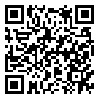1. Agudo-Peregrina AF, Hernández-García A, Iglesias-Pradas S. Predicting academic performance with learning analytics in virtual learning environments: a comparative study of three interaction classifications. In: International Symposium on Computers in Education (SIIE)[Internet]. Andorra la Vella, Andorra: IEEE; 2012. pp:1–6.
2. Kako Joybari AA, Shojai H, Mohtashami T. A comparison of reading literacy perception levels in fourth grade primary school students with visual impairment and normal sighted students. Psychology of Exceptional Individuals. 2011;1(3):55–70. [Persian] [
Article]
3. American Psychiatric Association. Diagnostic and statistical manual of mental disorders (DSM-5). 5th edition. Arlington, VA: American Psychiatric Pub; 2013.
4. Fadaei Vatan Z, Estaki M, Ghanbari Panah A, Kochak Entezar R. Comparison of mindfulness-based cognitive therapy and cognitive reconstructing training effectiveness on social and emotional self-efficacy in students with learning problems. Psychology of Exceptional Individuals. 2020;9(35):169–92. [Persian] [
Article]
5. Brodersen J, Schwartz LM, Heneghan C, O'Sullivan JW, Aronson JK, Woloshin S. Overdiagnosis: what it is and what it isn't. BMJ Evidence-Based Medicine. 2018;23(1):1–3. [
DOI]
6. Lueck AH, Dutton GN, Chokron S. Profiling children with cerebral visual impairment using multiple methods of assessment to aid in differential diagnosis. Seminars in Pediatric Neurology. 2019;31:5–14. [
DOI]
7. Alizade H, Aminabadi Z, Biabangard E, Ebrahimi Ghavam S, Farokhy N. Response to intervention: a diagnostic and treatment approach for learning disorders. Middle Eastern Journal of Disability Studies. 2017;7:57. [Persian] [
Article]
8. Scruggs TE, Mastropieri MA, Cook SB, Escobar C. Early intervention for children with conduct disorders: a quantitative synthesis of single-subject research. Behavioral Disorders. 1986;11(4):260–71. [
DOI]
9. Kadesjö B, Janols LO, Korkman M, Mickelsson K, Strand G, Trillingsgaard A, et al. The FTF (five to fifteen): the development of a parent questionnaire for the assessment of ADHD and comorbid conditions. European Child & Adolescent Psychiatry. 2004;13(S3):3–13. [
DOI]
10. Raue K, Lewis L. Students with disabilities at degree-granting postsecondary institutions. NCES 2011-018. Washington, DC: US Government Printing Office; 2011. [
Article]
11. Shirazi TS, Nili Pour R. Design and standardization of a diagnostic reading test. Journal of Rehabilitation. 2004;5(1&2):7–11. [Persian] [
Article]
12. Soleimani Z, Dastjerdi Kazemi M. Ta'yeen reva’ee va etebare azmoone agahi vaj shenakhti [Determining the validity and reliability of phonological awareness test]. Journal of Psychology. 2005;9(1)33):82–100. [Persian]
13. Wechsler D. Wechsler Intelligence Scale for Children–fourth edition (WISC-IV). San Antonio, TX: The Psychological Corporation; 2003.
14. Nazari S, Kooti E, Saiahi H. Learning disorder diagnostic criteria in the revised intelligence standard and Wechsler's children. Exceptional Education. 2012;1(109):36–45. [Persian]
15. Aminabadi Z, Alizade H, Saadi Pour E, Ebrahimi Ghavam S, Farokhi NA. Development and evaluation of effectiveness of response to intervention (RtI) program on academic skills reading, spelling and mathematical in students with learning programs. [PhD dissertation in Educational Psychology]. [Tehran, Iran]: Faculty of Psychology and Education, Allameh Tabataba,i. 2017. pp: 136-59. [Persian]
16. Johnson E, Mellard DF, Fuchs D, McKnight MA. Responsiveness to intervention (RTI): how to do it. [RTI Manual]. National Research Center on Learning Disabilities. 2006.
17. Wolcott HF. Writing up qualitative research ... better. Qualitative Health Research. 2002;12(1):91–103. [
DOI]
18. Denton CA. Response to intervention for reading difficulties in the primary grades: some answers and lingering questions. Journal of Learning Disabilities. 2012;45(3):232–43. [
DOI]
19. Parks N. The impact of response to intervention on special education identification [PhD dissertation]. [Georgia]: Department of Leadership, Technology, and Human Development, Georgia Southern University; 2011.
20. Vaughn S, Wexler J, Leroux A, Roberts G, Denton C, Barth A, et al. Effects of intensive reading intervention for eighth-grade students with persistently inadequate response to intervention. Journal of Learning Disabilities. 2012;45(6):515–25. [
DOI]
21. Vaughn S, Ortiz A. Response to intervention in reading for English language learners [Internet]. 2007.
22. Aravena S, Tijms J, Snellings P, Van Der Molen MW. Predicting responsiveness to intervention in dyslexia using dynamic assessment. Learning & Individual Differences. 2016;49:209–15. [
DOI]
23. Reutebuch CK. Succeed with a response-to-intervention model. Intervention in School & Clinic. 2008;44(2):126–8. [
DOI]
24. Scheltinga F, Van Der Leij A, Struiksma C. Predictors of response to intervention of word reading fluency in Dutch. Journal of Learning Disabilities. 2010;43(3):212–28. [
DOI]
25. Linan-Thompson S, Vaughn S, Prater K, Cirino PT. The response to intervention of English language learners at risk for reading problems. Journal of Learning Disabilities. 2006;39(5):390–8. [
DOI]
26. Carroll JM, Holliman AJ, Weir F, Baroody AE. Literacy interest, home literacy environment and emergent literacy skills in preschoolers. Journal of Research in Reading. 2019;42(1):150–61. [
DOI]
27. Tamis-LeMonda CS, Rodriguez ET. Parents’ role in fostering young children’s learning and language development. In: Fromberg D, Williams L, editors. Encyclopedia on early childhood development. First edition. New York University; 2008.
28. Catts HW. The relationship between speech-language impairments and reading disabilities. Journal of Speech, Language, and Hearing Research. 1993;36(5):948–58. [
DOI]
29. Lange SM, Thompson B. Early identification and interventions for children at risk for learning disabilities. International Journal of Special Education. 2006;21(3):108–19.
30. Del Prette ZA, Del Prette A, De Oliveira LA, Gresham FM, Vance MJ. Role of social performance in predicting learning problems: prediction of risk using logistic regression analysis. School Psychology International. 2012;33(6):615–30. [
DOI]

 ، حمید علیزاده2
، حمید علیزاده2 
 ، اسماعیل سعدی پور3
، اسماعیل سعدی پور3 
 ، صغرا ابراهیمی قوام3
، صغرا ابراهیمی قوام3 
 ، نورعلی فرخی4
، نورعلی فرخی4 




